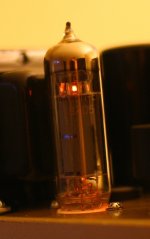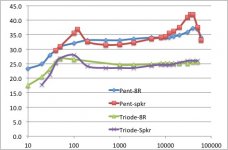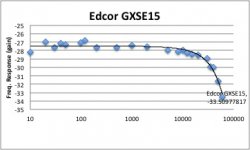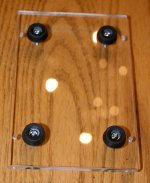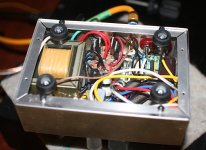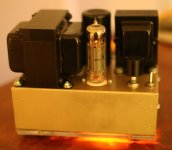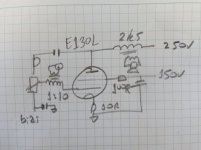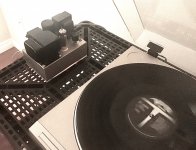I could never be a surgeon, can't stand the sight of electrons
When you see them.....it's too late!
When you see them.....it's too late!
QUICK! grab all the magic smoke and put it back in!!!
Also, what do you think, per the listening tests? Interested to see what you think about it w.r.t some other drivers. I, myself finished up my aikido amp the other week and it's quite a wonderful driver as well, ever with the low-Z that my cans have.
Also, I forget in the original SPUD discussion did we say if sand was allowed or not? I'm thinking of doing a sub-mini tube hybrid OTL driver.....
Member
Joined 2009
Paid Member
Also, what do you think, per the listening tests? Interested to see what you think about it w.r.t some other drivers.
I'm not sure if this question is for me - the Yukon Gold spud amp sounds just fine to me 🙂
With large single full range driver (AN 15) in open back box - plenty of volume, deeep bass.
As for other drivers, I don't have enough experience to comment (yet).
did we say if sand was allowed or not?
If it's your amp, use whatever you fancy. I used sand rectifiers. Adding three-terminal sand devices opens up huge possibilities.
As for other drivers, I don't have enough experience to comment (yet).
See that's my problem too. (myself) Coming from nothing, quite frankly everything seems revelatory 😀 I noticed a HUGE increase in clarity, or maybe definition more so than clarity and more dynamic response when I plugged in my SRPP stage. Excited to get that in its own box.
I've got some 55ohm open-backs, with the lower Z I'm interested to see if something other than a cathode follower in OTL would be better....
If it's your amp, use whatever you fancy. I used sand rectifiers. Adding three-terminal sand devices opens up huge possibilities.
Right, As with Eli's modification to the RCA phono stage, adding the SS output really helps with Z-matching and drive capabilities. There's a very well known audio company that uses a sub-mini triode-straped gain stage with a solid output.....thinking of going that way. *technically* still is a SPUD. Maybe more like a tater' with some wires sticking out of it a-la battery science fair project 😛
Member
Joined 2009
Paid Member
The SRPP is a form of Follower (the top tube) so it provides a lower output impedance and depending on the standing current it can provide more drive.
Thing is, SS is a better choice for Followers. And for rectifiers for that matter. In terms of performance, SS simply crushes hollow-state into the ground for these applications (when used properly). For a Follower, the key parameter is the transconductance of the device.
Thing is, SS is a better choice for Followers. And for rectifiers for that matter. In terms of performance, SS simply crushes hollow-state into the ground for these applications (when used properly). For a Follower, the key parameter is the transconductance of the device.
Member
Joined 2009
Paid Member
Grid casts blue glow on inside of plate
This is pretty cool !
Look through the small window in the plate structure and you'll see some blue lines on the inside surface
[ it is apparently, not an issue Blue Glow in Electron tubes ]
This is pretty cool !
Look through the small window in the plate structure and you'll see some blue lines on the inside surface
[ it is apparently, not an issue Blue Glow in Electron tubes ]
Attachments
Member
Joined 2009
Paid Member
I made some updates today.
I've increased the value of R2 from 4k7 to 14k7 in order to reduce the screen-grid current and in turn lower the voltage on the screen-grid to give the plate more headroom to swing. Plus, those who have been tweaking this topology over at Hawthorne Audio forum recommend a lower screen-grid voltage in their version.
I also increased the C3 (plate to screen feedback cap), doubling it up by placing another cap in parallel with the first for a total of 136nF.
The new operating point becomes:
B+ 268V
Va-k 262V
Vg2-k 171V
Vk 3.79V
ig2 3.8mA
ia 27.3mA
Pwr(g2) 0.65W
Pwr(a) 7.2W
I also hooked up the ole signal generator to play some sine waves and makes some measurements of the amplifier gain/frequency response with both an 8R resistive load and a single full range speaker ( http://www.diyaudio.com/forums/full-range/280669-improving-chn-70-a.html ) I wore my Bose sound cancelling headphones for this part !!!!.
The FR plot shows the frequency response at the anode in Pentode and Triode mode with the two different output load conditions. The speaker produces a tell-tale hump in the base region around 100Hz to 120Hz (hmmm, box is tuned a little high maybe ?). The overall gain with plate-to-screen feedback (Triode mode) is clearly lower as expected. The benefits of this feedback also show up as a flatter frequency response.
However, the pentode mode with it's higher output impedance shows a rising gain with frequency along with some resonance peaking in the treble at 35kHz. The horizontal scale on both charts is frequency in Hz (log scale). The vertical scale on the first chart is gain (dB) at the anode; the vertical scale on the second chart is gain (dB) of the OPT - since it is a step-down transformer the gain is less than unity.
At 10Hz I could easily see the cathode bias LED brightness flicker - a sign that the dynamic resistance of these LEDs is greater than zero at these low frequencies. Do I care ?
I was able to measure the signal at the anode and the output of the OPT and use it to get an FR plot of the Edor transformer. It looks pretty decent indeed. There is a resonance in the OPT at around 68kHz and the waveform gets distorted at the extremes of frequency - outside the range of interest.
I've increased the value of R2 from 4k7 to 14k7 in order to reduce the screen-grid current and in turn lower the voltage on the screen-grid to give the plate more headroom to swing. Plus, those who have been tweaking this topology over at Hawthorne Audio forum recommend a lower screen-grid voltage in their version.
I also increased the C3 (plate to screen feedback cap), doubling it up by placing another cap in parallel with the first for a total of 136nF.
The new operating point becomes:
B+ 268V
Va-k 262V
Vg2-k 171V
Vk 3.79V
ig2 3.8mA
ia 27.3mA
Pwr(g2) 0.65W
Pwr(a) 7.2W
I also hooked up the ole signal generator to play some sine waves and makes some measurements of the amplifier gain/frequency response with both an 8R resistive load and a single full range speaker ( http://www.diyaudio.com/forums/full-range/280669-improving-chn-70-a.html ) I wore my Bose sound cancelling headphones for this part !!!!.
The FR plot shows the frequency response at the anode in Pentode and Triode mode with the two different output load conditions. The speaker produces a tell-tale hump in the base region around 100Hz to 120Hz (hmmm, box is tuned a little high maybe ?). The overall gain with plate-to-screen feedback (Triode mode) is clearly lower as expected. The benefits of this feedback also show up as a flatter frequency response.
However, the pentode mode with it's higher output impedance shows a rising gain with frequency along with some resonance peaking in the treble at 35kHz. The horizontal scale on both charts is frequency in Hz (log scale). The vertical scale on the first chart is gain (dB) at the anode; the vertical scale on the second chart is gain (dB) of the OPT - since it is a step-down transformer the gain is less than unity.
At 10Hz I could easily see the cathode bias LED brightness flicker - a sign that the dynamic resistance of these LEDs is greater than zero at these low frequencies. Do I care ?
I was able to measure the signal at the anode and the output of the OPT and use it to get an FR plot of the Edor transformer. It looks pretty decent indeed. There is a resonance in the OPT at around 68kHz and the waveform gets distorted at the extremes of frequency - outside the range of interest.
Attachments
Last edited:
Member
Joined 2009
Paid Member
I decided to fashion a cover plate for the bottom of the amplifier using thick perspex/acrylic. I get to look at the birds nest inside and the cathode bias LEDs light up the table-top as a convenient 'power on' indicator 🙂
Attachments
Last week I got two E130L as a gift, and couldn't resist prototyping a SPUD with them. I used the datasheet values (see attachment) for the operation points. At the input I used a Hammond 107X (reversed this gives a step-up of 1:10) with Schade Feedback applied. I was indeed getting about 10W out, but with a lot of distortion. I then dialed the feedback so that I could still get about 5W out with 1.3VRMS in (which is what my DAC puts out). At this setting the THD at 1W (1khz) was about 0.6% - not that bad.
At higher frequencies the THD was raising. I also did a STEPS (from Arta). At LF distortion was terrible, as could be expected with the little Hammond, but from about 120Hz onwards it stabilized at about the 0.6% at 1W, going to about 1% THD at 10kHz.
The step-up would probably not work with triodes and SS because of the capacitances, but with pentode I had some hope 🙂
Edit: for the feedback string I used a 2.2uF cap, 220k resistor and 100k pot (to easily adjust the FB ratio).
I have some other priorities now, but I could see this working nicely.
Erik
At higher frequencies the THD was raising. I also did a STEPS (from Arta). At LF distortion was terrible, as could be expected with the little Hammond, but from about 120Hz onwards it stabilized at about the 0.6% at 1W, going to about 1% THD at 10kHz.
The step-up would probably not work with triodes and SS because of the capacitances, but with pentode I had some hope 🙂
Edit: for the feedback string I used a 2.2uF cap, 220k resistor and 100k pot (to easily adjust the FB ratio).
I have some other priorities now, but I could see this working nicely.
Erik
Attachments
Member
Joined 2009
Paid Member
Man, I hooked up the Yukon Gold today. It’s playing through my big Audio Nirvana 15” Super Ferrite Big’un speaker. The source is my Pioneer PL-2 turntable with an unknown cartridge (maybe ortofon) playing Getz/Gilberto (1964 but re-released 2020). Phono amp coutesy of my Marantz 1530.
Now, it sounds just wonderful. The EL84 is switched into pure triode mode and the volume is low as this is a sensitive speaker. Bass smooth and deep, no treble harshness, no hum at all. Could it be better? - there’s not quite the clarity and openness I enjoy from my SS amps which maybe an OPT limitation, or it’s further upstream.
So why do I have 3 or 5 expensive tube amp projects in various states of build, parts carefully sourced over the past few years, chassis all drilled and painted, lots of work put in, lots more required.
It just kills me that my junk box spud amp leaves me struggling to justify building anything else when the improvement maybe minor? 🤔
I guess there’s only one way to find out.
Now, it sounds just wonderful. The EL84 is switched into pure triode mode and the volume is low as this is a sensitive speaker. Bass smooth and deep, no treble harshness, no hum at all. Could it be better? - there’s not quite the clarity and openness I enjoy from my SS amps which maybe an OPT limitation, or it’s further upstream.
So why do I have 3 or 5 expensive tube amp projects in various states of build, parts carefully sourced over the past few years, chassis all drilled and painted, lots of work put in, lots more required.
It just kills me that my junk box spud amp leaves me struggling to justify building anything else when the improvement maybe minor? 🤔
I guess there’s only one way to find out.
Attachments
Last edited:
Do you have the complete scheme?Well there was a guitar Amp contest/thread for $200 max parts cost, or something such. George/Tubelab would have the particulars.
Some other themes in the past have been the most in-efficient Amp. But that was too easy.
Using the most tubes would be interesting, but the tube sockets cost way more than the cheapest TV tubes.
Getting 20 frame grid tubes to work in parallel, without oscillating, might be an interesting theme. This could form a single stage Amp.
Or how about getting 100 Watts from a 12AX7 for so many uSecs. (Ehh, we already know George would win that one)
"Potato Growers Association"
Wouldn't that be the PGA? I always wondered what they hit around before the invention of the golf ball.
- Home
- Amplifiers
- Tubes / Valves
- Yukon Gold - a spud amp
